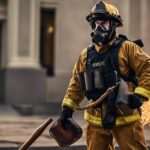Turnout Gear Lawsuit
In a world where heroes are cloaked in armor, it's unimaginable that their very protection could be their downfall. We've been following the Turnout Gear Lawsuit with a balanced eye, witnessing a David versus Goliath battle as firefighters stand against the giants of the gear manufacturing world. The heart of the issue lies in the use of PFAS, chemicals that are as dangerous as they are ubiquitous, found in the gear that's supposed to shield our bravest. The unfolding legal drama not only seeks reparation but also aims to rewrite the narrative on safety standards. As the courtroom battles heat up, one can't help but wonder: where will the chips fall, and what does this mean for the future of our firefighters?

Key Takeaways
- Firefighters are suing gear manufacturers over cancer risks linked to PFAS exposure in turnout gear.
- Over 40 gear manufacturers, including 3M, BASF, and DuPont, face lawsuits for allegedly knowing the dangers of PFAS.
- Legal battles aim for accountability, justice, and compensation for cancer believed to be caused by PFAS in firefighting gear.
- NFPA 1971 standards currently mandate the inclusion of PFAS in firefighter gear, raising health concerns amidst ongoing lawsuits.
Firefighter Cancer Deaths Surge
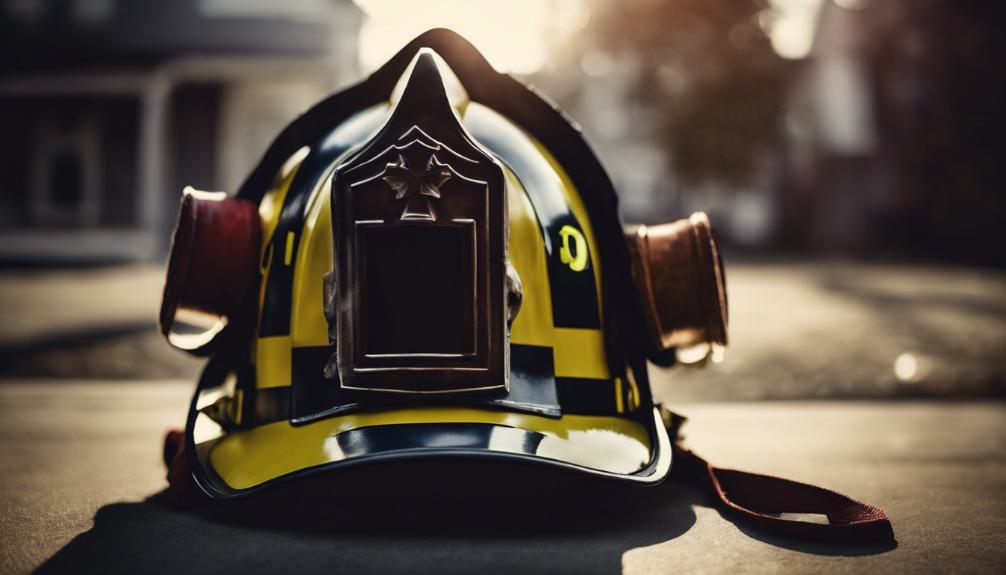
We've witnessed a disturbing surge in firefighter cancer deaths, now eclipsing heart disease as the leading cause of fatalities in the profession. This alarming trend isn't just a statistic; it's a stark reality that 66% of firefighter deaths from 2002 to 2019 were due to cancer. By 2022, this figure rose, with 75% of names added to the IAFF Fallen Fire Fighter Memorial Wall attributed to occupational cancer. It's a crisis that's been silently escalating, hidden beneath the heroism associated with firefighting.
The heart of the issue lies in the very gear designed to protect us. Studies have revealed elevated levels of PFAS contamination in our protective gear. PFAS, a group of chemicals known for their durability and resistance to heat, water, and oil, have been linked to several health issues, including cancer. It's a bitter irony that the equipment we rely on for safety could be contributing to the high risk of cancer diagnosis among firefighters. As we confront this reality, it's clear that our fight is not just against fire but against the unseen dangers lurking in our firefighting equipment.
Legal Battles Emerge

Amid this crisis, firefighters are now taking their battle from the firehouse to the courthouse, filing lawsuits against gear manufacturers like 3M and DuPont for exposing them to cancer-causing PFAS. These legal battles underscore the gravity of the situation as we demand accountability for the safety of our protective gear. We've trusted this equipment to shield us from the immediate dangers of fire, only to find ourselves facing a more insidious threat.
The momentum of these lawsuits is undeniable. With 3M's proposed $10.5 billion settlement being commended by a federal judge, it's clear that our concerns are being taken seriously. Moreover, the addition of 279 new cases to the AFFF class action MDL echoes our collective call for justice. Across the United States, from the water contamination claims to Tennessee joining the ranks of states suing PFAS manufacturers, the legal landscape is shifting.
With over 5,000 pending cases in the MDL involving turnout gear, our fight is far from over. Yet, as we navigate these legal battles, our resolve only strengthens. We're not just fighting for ourselves but for the safety and well-being of firefighters everywhere. The stakes couldn't be higher, and we're determined to see this through.
The Role of PFAS
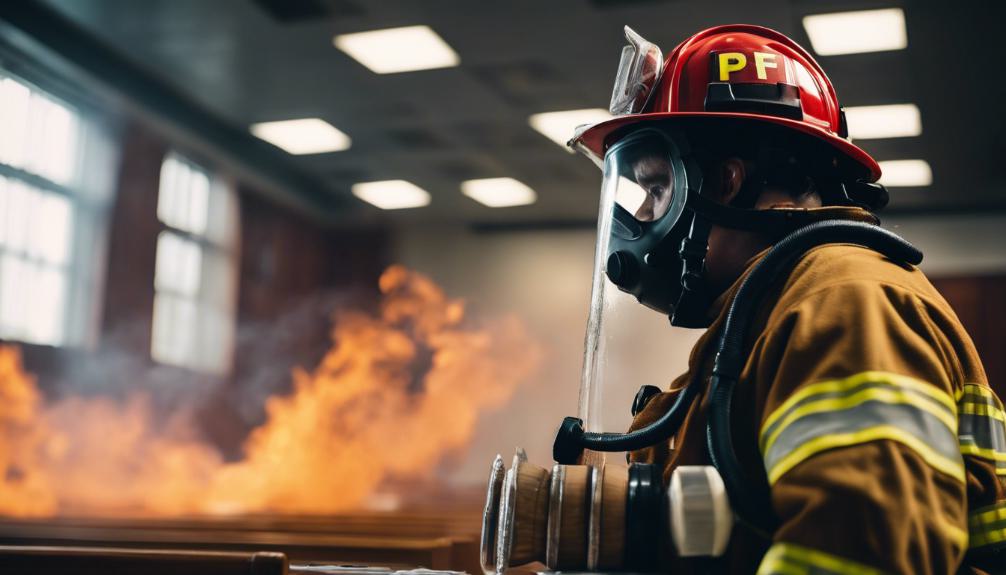
PFAS, dubbed 'forever chemicals,' are integral to firefighters' turnout gear, offering essential resistance to water and oil. These chemicals are woven into the very fabric of the protective clothing that firefighters don every day, aiming to shield them from the hazardous environments they face. However, the presence of PFAS in firefighting gear isn't without its controversies. Studies have revealed that each sample of firefighter gear contains 1 to 17 types of PFAS, underscoring their widespread use in these critical pieces of equipment.
The health risks associated with PFAS are concerning. These forever chemicals, known for their persistence in both the environment and the human body, can accumulate over time. For firefighters, this means that prolonged exposure to PFAS through their turnout gear could lead to elevated levels of these harmful substances in their blood serum. This, in turn, increases their risk of experiencing adverse health effects.
We're now facing the reality that the very gear designed to protect our firefighters from immediate dangers may also be exposing them to long-term health risks. The challenge lies in balancing the need for effective protective clothing with the imperative to safeguard the health of those who wear it.
Gear Manufacturers Under Scrutiny
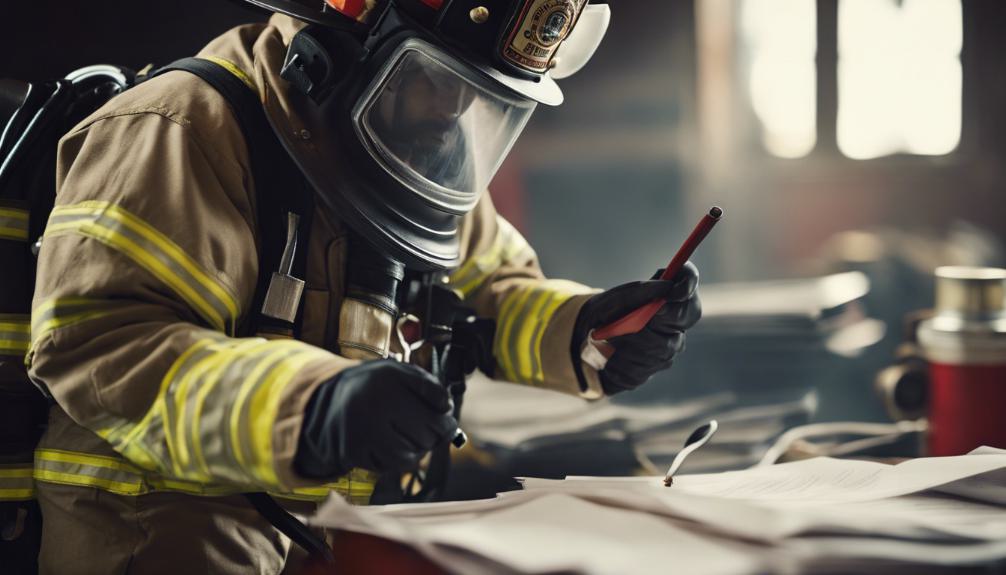
In recent years, over 40 gear manufacturers, including industry giants like 3M, BASF, and DuPont, have found themselves at the center of lawsuits filed by firefighters for producing turnout gear containing cancer-causing PFAS. We've watched as this issue has unfolded, drawing attention to the critical balance between safety and health in the production of firefighter gear. The lawsuits signal a growing concern over the presence of PFAS in turnout gear, a material known for its durability and protective qualities but now under scrutiny for its health implications.
Among those facing legal challenges are top manufacturers such as DuPont, TenCate, Honeywell, Lion Apparel, and Globe Holding Company. Despite the known health hazards, efforts to remove PFAS from firefighter gear have met obstacles, partly due to NFPA 1971 standards. These standards mandate the inclusion of PFAS for light degradation resistance, complicating the push towards safer alternatives.
The NFPA Council's decision in 2021 to retain PFAS in gear specifications has only fueled the fire, leading to increased legal actions from firefighters concerned about their health. As we continue to monitor these developments, the debate over PFAS in turnout gear remains a pivotal concern, underscoring the need for safer solutions that don't compromise firefighter safety.
Health Risks Identified
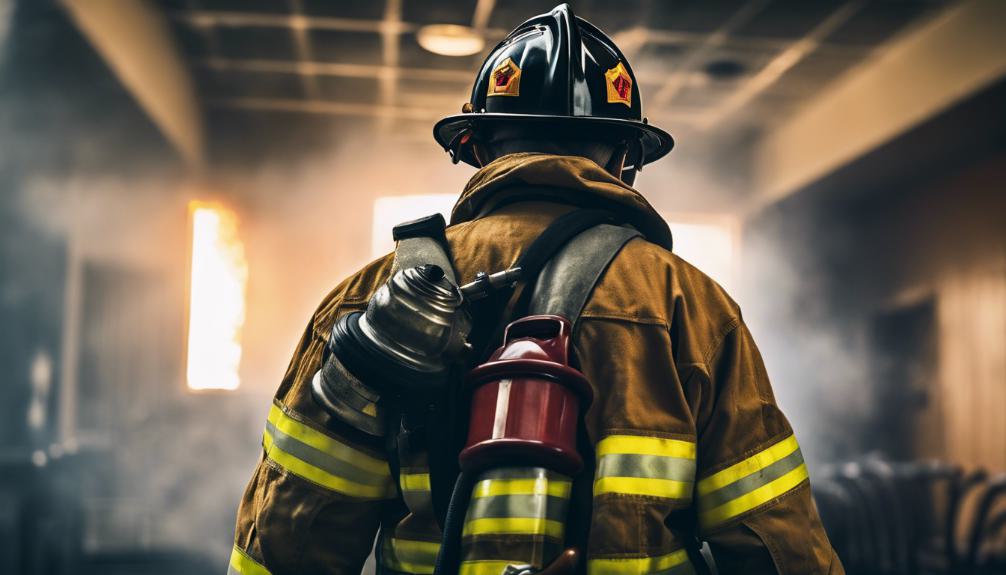
As we continue exploring the issues surrounding firefighter gear, it's imperative to address the identified health risks associated with PFAS exposure. Studies have highlighted concerning levels of these 'forever chemicals' in firefighters' protective turnout gear. The presence of PFAS in the textiles of this gear isn't just alarming due to their persistence but also because of the direct health implications for those who wear them. Firefighters, in their critical roles, are exposed to these substances, which accumulate in the body, elevating their risk of developing serious health conditions, including cancer.
The use of PFAS in turnout gear is primarily for its water and oil resistance properties, ensuring firefighters' protection against the elements and hazards they face. However, this protective measure has a dark side. Elevated levels of PFAS in firefighters' blood serum point to a significant exposure route through their gear. The correlation between PFAS exposure and increased cancer risks among firefighters can't be ignored. It's clear that while turnout gear is essential for firefighters' safety, the inclusion of PFAS in its fabrication raises serious concerns about the long-term health impacts on these brave individuals.
Lawsuit Overview

As we explore the 'Lawsuit Overview', we'll look into the legal claims brought forth by the firefighters and the entities they've challenged, including heavyweights like 3M and DuPont. We aim to clarify the basis of these lawsuits and the demands for accountability and compensation. Understanding the roles of plaintiffs and defendants here is essential for grasping the full scope of the legal battle.
Legal Claims Explained
Firefighters have launched lawsuits against more than 40 gear manufacturers, accusing them of knowingly using cancer-linked PFAS in turnout gear. These legal actions allege that the presence of PFAS in firefighter turnout gear has directly caused cancer among our ranks. We're determined to hold these manufacturers accountable for their decisions to continue using PFAS, despite being aware of the health risks involved. Our goal is not just to seek compensation but to also guarantee justice for the devastating health impacts we've endured due to exposure to these harmful chemicals. Additionally, families of our fallen comrades, who've lost their lives to qualifying medical conditions linked to PFAS exposure in the past three years, are stepping forward to file lawsuits. We're united in this fight for accountability and safety.
Defendants and Plaintiffs
Moving on to an overview of the lawsuit, we're taking on over 40 gear manufacturers, including industry giants like 3M, BASF, and DuPont, for their role in exposing us to cancer-causing PFAS through our turnout gear. As firefighters and first responders, the reality that our very protection could be the source of severe health risks is alarming. These lawsuits are a stand against years of negligence where manufacturers allegedly knew the dangers of PFAS in firefighter turnout gear but continued its use. We're seeking accountability, justice, and compensation for the cancer we believe was caused by this exposure. It's about making sure that the safety of those who risk everything is never compromised again.
Current Legal Updates

We're now shifting our focus to the most recent updates in the legal battles surrounding firefighter turnout gear. Understanding the scope of the challenges and the developments in recent cases is crucial. These updates not only reflect the ongoing legal complexities but also underscore the growing response to the issues at hand.
Legal Challenges Overview
The legal landscape surrounding turnout gear lawsuits has seen significant developments, with new cases adding to the complex challenge of addressing PFAS-related health concerns. We've learned that firefighters have courageously stepped forward, filing lawsuits against 27 gear manufacturers, including giants like 3M and DuPont, for their gear containing cancer-causing PFAS. This action underscores the gravity of the legal challenges we're confronting, aimed at safeguarding our health and environment from the repercussions of PFAS exposure. A federal judge's commendation of 3M's $10.5 billion settlement proposal in the turnout gear lawsuit marks a pivotal moment in our ongoing battle. The surge in legal actions, including those concerning drinking water contamination, highlights the widespread impact of PFAS, reinforcing our commitment to pursuing justice for affected communities.
Recent Case Developments
In recent developments, a federal judge has praised 3M's $10.5 billion settlement proposal in the firefighter turnout gear lawsuit, marking a significant step forward in addressing the complex challenges posed by PFAS-related health concerns. We've seen a flurry of activity, with 279 new cases added to the AFFF class action MDL, highlighting the ongoing legal battles against PFAS manufacturers. Additionally, settlements concerning municipal water contamination claims related to turnout gear show progress in tackling the broader implications of these chemicals. Tennessee's decision to join other states in suing PFAS manufacturers underscores the growing legal response to this issue. However, the breakdown between water contamination and cancer cases among the more than 5,000 pending MDL cases remains uncertain, complicating our understanding of the full impact of fire-fighting foam and gear contamination.
Understanding Turnout Gear

To effectively protect themselves during operations, firefighters don specialized turnout gear, which is meticulously engineered to shield against heat, flames, and hazardous contaminants. This gear, central to their safety, includes multilayered coats and pants designed not just for durability but for maximum protection. It's a critical part of their arsenal, allowing them to enter and move through dangerous environments that would otherwise be impenetrable.
However, the very materials that make this protective clothing so effective come with their own set of concerns. Manufacturers have incorporated PFAS into turnout gear for its exceptional water- and oil-resistant properties. These chemicals help keep firefighters dry and prevent hazardous substances from penetrating their gear. Yet, studies have unearthed high levels of PFAS in firefighting gear, sparking significant worry about the potential health risks they pose to those who wear them.
Despite these concerns, NFPA standards currently mandate the use of PFAS in turnout gear to meet stringent safety requirements. This creates a complex scenario where the very equipment designed to protect firefighters might also be contributing to health risks. We're maneuvering a fine line between ensuring immediate physical safety and considering long-term health impacts.
Exposure to Forever Chemicals
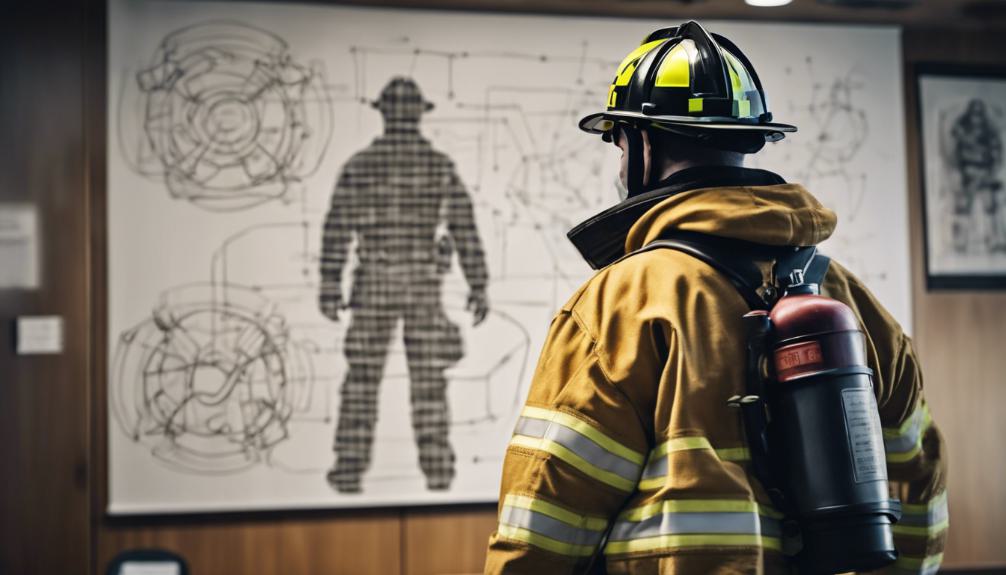
We've uncovered the risks firefighters face from PFAS in their gear, leading to serious health concerns. Legal steps are being taken to address these dangers, pushing manufacturers to find safer alternatives. Our focus now shifts to understanding these risks, the legal battles underway, and the pursuit of chemical substitutes.
Health Risks Identified
Facing exposure to 'forever chemicals' in their turnout gear, firefighters are at risk of accumulating harmful PFAS in their bodies, which has been linked to various diseases. Studies have highlighted the severity of this issue, detecting up to 17 types of PFAS in firefighter gear samples. This exposure is not trivial; it's a significant health risk that's raising alarms about the long-term impacts on those in the firefighting profession. The fact that firefighters have higher levels of PFAS in their blood serum than the general population underscores a direct link between their gear and health risks. Given the widespread presence of PFAS, even in drinking water affecting nearly 110 million Americans, it's clear we're facing a pervasive challenge. This lawsuit isn't just about gear; it's about protecting our health and future.
Legal Actions Initiated
Amidst growing concerns, firefighters have taken legal action against manufacturers for the harmful exposure to PFAS in their turnout gear. These lawsuits aim to hold these companies accountable for the significant health impacts we're facing, including cancer. Despite knowing the risks, manufacturers continued to use PFAS, a decision that's now under legal scrutiny. As members of the firefighting community, supported by the International Association of Fire Fighters (IAFF) and guided by standards set by the National Fire Protection Association, we're seeking justice and compensation. We're not just fighting fires; we're battling for our health against the invisible threat posed by PFAS in our gear. Through these legal actions, we're taking a stand to protect current and future firefighters from these avoidable risks.
Chemical Alternatives Explored
In response to the alarming findings, we're actively exploring safer chemical alternatives to replace PFAS in our turnout gear. Researchers have uncovered high levels of PFAS, notorious as 'forever chemicals', in the fabric of firefighters' protective clothing. Each piece of gear tested revealed between 1 to 17 types of PFAS, heightening concerns about the health risks associated with prolonged exposure. Given that PFAS can accumulate in the body, increasing the likelihood of disease, it's critical we find alternatives. The presence of these chemicals in turnout gear places firefighters at an elevated risk of exposure, underscoring the urgency of our quest for safer options. We're committed to safeguarding our firefighters from these forever chemicals by identifying and implementing healthier substitutes for PFAS in their gear.
Failed Efforts to Eliminate PFAS
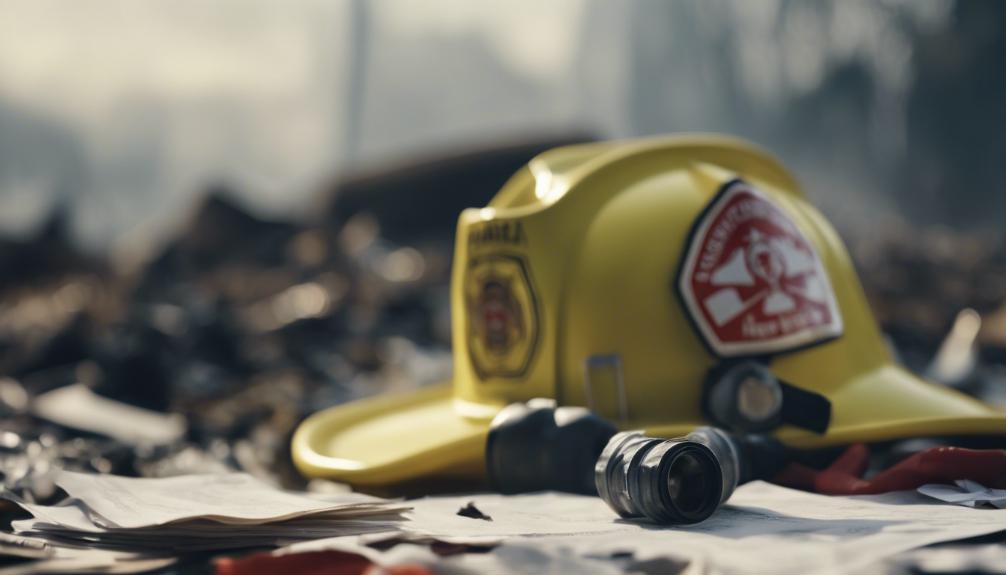
Despite concentrated efforts, we've been unable to eliminate PFAS from firefighter turnout gear due to regulatory and manufacturing constraints. The International Association of Fire Fighters (IAFF) filed a substantial lawsuit against the National Fire Protection Association (NFPA), challenging the standards that mandate the use of PFAS in firefighter gear. These standards, which are designed to assure the safety and effectiveness of protective turnout gear, have inadvertently caused health risks by continuing to require PFAS in the equipment's fabrication.
The proposed amendments in 2021 aimed at addressing the health hazards posed by PFAS in firefighter gear highlighted the industry's struggle. Unfortunately, these efforts were met with resistance, and the NFPA Council voted to retain PFAS in turnout gear despite the known health risks. This decision underscores the challenges we face in eliminating these harmful chemicals from our gear. Manufacturers, adhering to NFPA standards, continue to incorporate PFAS in each layer of turnout gear, further complicating efforts to find safer alternatives.
The refusal to eliminate PFAS from our gear, despite its association with significant health risks, highlights a critical issue within the firefighting industry. We're left grappling with regulatory and manufacturing barriers that hinder our progress towards safer working conditions.
Leading Gear Manufacturers

We'll now examine the role of leading gear manufacturers like DuPont and TenCate in the ongoing debate over PFAS in firefighter turnout gear. These companies, alongside others such as Honeywell, Lion Apparel, and Globe Holding Company, are at the forefront of producing equipment that adheres to the stringent safety standards set forth by NFPA. Specifically, NFPA 1971 mandates requirements for firefighter turnout gear, including the use of materials with PFAS to resist light degradation. This specification underscores the complex balance manufacturers must strike between ensuring the safety and durability of gear and addressing the health concerns associated with PFAS.
The efforts to remove PFAS from turnout gear have been met with significant challenges, largely due to the current safety standards and industry regulations that prioritize certain performance metrics. The involvement of these manufacturers in producing gear containing PFAS has become a central issue in the recent lawsuit against the firefighting gear industry. This lawsuit highlights the tension between meeting NFPA safety standards and the push for eliminating potentially harmful substances from firefighter equipment. As manufacturers navigate these waters, the debate continues to unfold, spotlighting the intricate relationship between safety regulations, industry practices, and health concerns.
Increased Cancer Risk for Firefighters
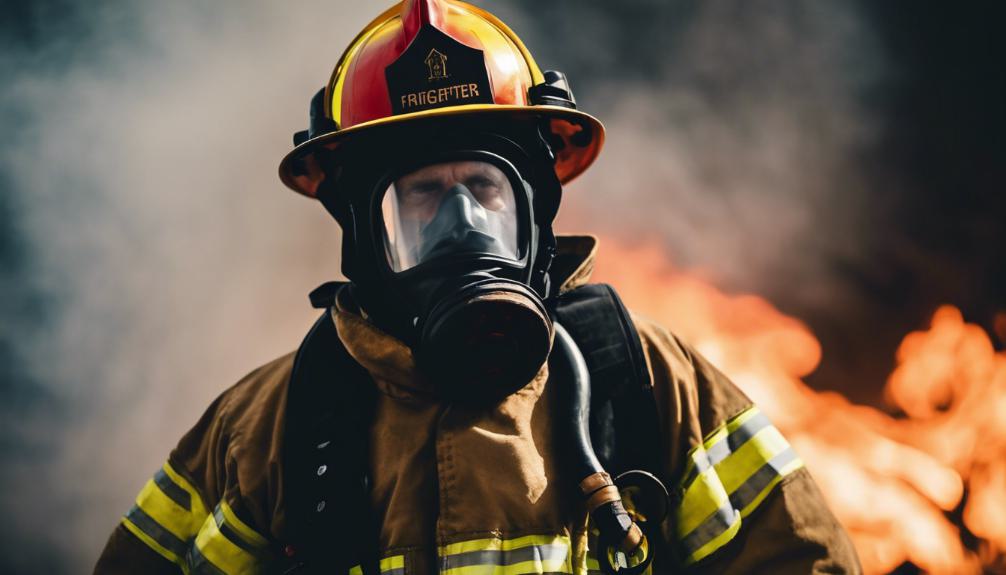
As firefighters don our gear to battle blazes, we're unknowingly exposed to PFAS, greatly increasing our risk of developing cancer. This hidden danger within our turnout gear, essential for our protection against the inferno, ironically contributes to a sinister threat. Studies have underscored the alarming correlation, revealing notably higher levels of cancer-causing PFAS in our blood serum compared to the general population. The very fabric meant to shield us from flames now places us in the line of fire against an insidious enemy: cancer.
Cancer has stealthily overtaken heart disease as the leading cause of death among us. It's a stark reality that in 2019, over 75% of line-of-duty deaths were due to occupational cancer. This relentless adversary has not only claimed the lives of our brothers and sisters but has also sparked a determined fight for justice and safety.
The IAFF lawsuit represents our collective stand against the use of PFAS in firefighter gear. It's a pivotal battle in our ongoing war not just against the flames but against the increased cancer risk that shadows our noble profession. Through this legal action, we seek to safeguard our health and make sure our fight against fire doesn't come at the cost of our lives.
AFFF Litigation Insights

Expanding on our fight against PFAS in turnout gear, it's also important to highlight the ongoing AFFF litigation that underscores similar concerns over toxic exposure. AFFF lawsuits, much like those we're pursuing for turnout gear, focus on the critical issue of PFAS exposure, this time concerning drinking water contamination. As of November 2023, over 6,400 cases related to AFFF were pending, spotlighting the widespread impact of these toxic chemicals.
The heart of these legal actions is the accusation that manufacturers failed to warn about the hazards present in Aqueous Film Forming Foam (AFFF), a product used extensively by firefighters. These lawsuits have been consolidated in a South Carolina MDL (multidistrict litigation), streamlining the process to address these grievances collectively. This consolidation aims to efficiently manage the sheer volume of cases, ensuring that each one receives the attention it deserves.
The parallels between the AFFF lawsuits and those we're fighting regarding firefighter turnout gear are striking. Both legal battles revolve around the failure to warn about the dangers of PFAS exposure, underscoring a systemic issue of toxic chemical usage without adequate disclosure or safety measures.
Class Action Lawsuit Status
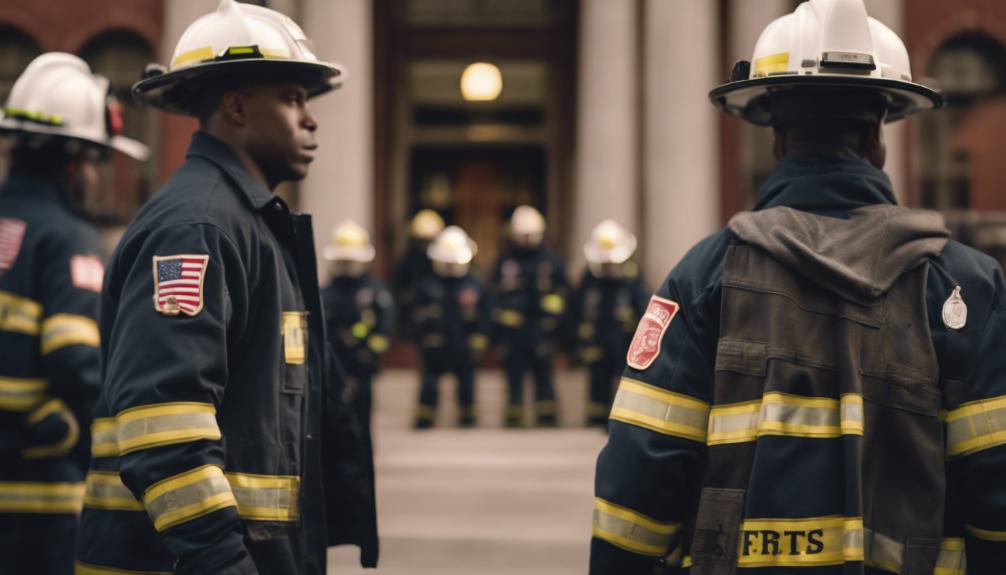
There's no ongoing multidistrict litigation for cancer cases linked to firefighter turnout gear as of November 2023. However, we've learned that individual lawsuits are stacking up against over 40 gear manufacturers. It's become clear that companies like 3M, BASF, and DuPont are in the hot seat for their role in PFAS lawsuits. These manufacturers are accused of using PFAS in turnout gear, fully aware of the firefighter health risks associated with these chemicals.
The firefighting community is standing up for its own, pushing hard against these manufacturer lawsuits. The heart of our fight is the undeniable link between PFAS exposure from our gear and the increased risk of cancer cases among us. We're not just talking about a few isolated incidents; this is a widespread concern that affects thousands of us across the nation.
We're also keeping a close eye on the potential for MDL consolidation. This move could streamline our legal battles, making it easier to address our grievances collectively. The possibility of consolidating new turnout gear PFAS cases into a federal MDL could be a game-changer in our fight for justice and safer working conditions.
Preventative and Legislative Actions
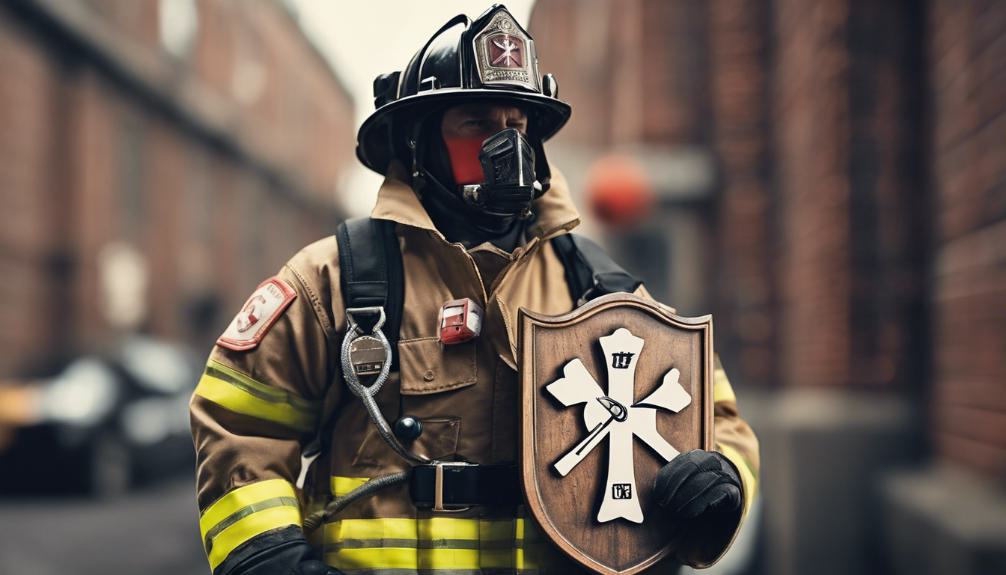
In light of the lawsuit, we're turning our focus to proactive measures that can be taken. Updating regulatory standards and establishing clear gear maintenance protocols are critical steps forward. These actions could greatly mitigate the health risks associated with PFAS in firefighter gear.
Regulatory Standards Update
We're closely monitoring the regulatory standards updates, specifically the preventative and legislative actions being taken to address the use of PFAS in firefighter turnout gear. Despite the NFPA Standard 1971 currently mandating the use of PFAS to meet safety requirements, there's a growing concern over the health hazards of PFAS. Efforts to remove PFAS from gear have been challenging, yet an amendment was proposed in 2021 aiming to address these risks. Unfortunately, the NFPA Council voted to retain PFAS in turnout gear, underlining the manufacturers' reliance on PFAS in each layer to safeguard protection. This decision underscores the complexity of balancing safety with health risks, highlighting the ongoing struggle to protect firefighters from the harmful effects of PFAS.
Gear Maintenance Protocols
Understanding the complexities of PFAS in turnout gear leads us to explore how maintaining and cleaning this equipment can mitigate health risks. Implementing regular cleaning and maintenance protocols for turnout gear is vital to prevent the spread of harmful PFAS chemicals. Legislative actions are being proposed to regulate PFAS use in firefighter gear and enforce stricter standards for gear maintenance. Proper decontamination procedures are essential to reduce exposure risks to PFAS and other toxic substances. Adhering to manufacturer guidelines for gear inspection and replacement guarantees the safety and effectiveness of protective equipment. Additionally, training programs focusing on gear maintenance and decontamination are essential for promoting firefighter health and reducing cancer risks associated with PFAS exposure.
Frequently Asked Questions
Is the AFFF Lawsuit Real?
Yes, we've found that the AFFF lawsuit is indeed real. It involves legal actions against manufacturers for not warning about the toxic chemical risks in firefighting foam, affecting drinking water and exposing people to harmful PFAS.
Who Qualifies for the AFFF Lawsuit?
We're looking into who qualifies for the AFFF lawsuit. If you've got kidney or testicular cancer, chronic kidney disease, thyroid disease, or ulcerative colitis from PFAS in firefighting foam, you might be eligible. Let's chat with a lawyer.
How Much Is the PFAS Lawsuit Settlement?
We've learned that the PFAS lawsuit settlement amount is $10.5 billion. It's a significant figure, aiming to resolve claims related to health risks, particularly cancer, believed to be caused by PFAS exposure.
Is Fire Fighting Foam Linked to Cancer?
We've learned that firefighting foam, specifically AFFF, is indeed linked to cancer due to its toxic PFAS chemicals. These substances are carcinogenic, raising our risk when we're exposed during firefighting operations.

This post has been generated by AI and was not reviewed by editors. This is Not legal advice. Please consult with an attorney.

